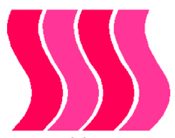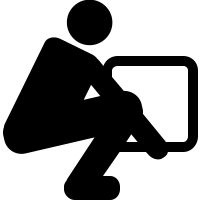“Clarifying the hip joints may help the back”
When you lift something truly heavy, do you bend your knees? You know that you should, and you probably do.
But when you lift something only somewhat heavy, do you bend your knees? You know that you should, and — possibly — you do not.
The man in the drawing is definitely bending his knees. It contributes to the impression that the object he is lifting is heavy.
Besides bending in his knees, he is also bending in his hip joints. To use somewhat coarser language, he is bending his knees and sticking his butt out. In some circumstances we may feel shy or vulnerable about doing this, but it is a critically important element.
Movement happens in patterns. In a healthy movement pattern, every part of the body contributes to the whole. By contrast, in an unhealthy movement pattern, some parts are idle. Then, other parts have to compensate. The compensating parts end up being overworked, and, sooner or later, they cry out in pain.
Young children bend easily in the hip joints, as do people in cultures where one sits on the floor. But in countries where one sits on chairs, and as the person gets older, and whenever there has been injury, the movement in the hip joints often, gradually and imperceptibly, diminishes.
The failure to bend in the knees and hip joints is one of the predictable causes of back injury. It can also lead to strain in other places, such as the neck and shoulders.
Besides this to-many-people-familiar bad news, there is less well-known good news, which is that the inverse is also true. Regaining healthy movement in the hip joints is a way to heal the back, as well as the neck, the shoulders and other parts. Restoring elastic, reliable, consistent movement in the hip joints is a good route for reducing pain and restoring strength and stamina throughout the body.
Exercises to clarify the hip joints include:
- while standing: squats and lunges with upper body counter rotation
- on hands and knees: cat-cow
- lying on your back: the pelvic clock.
Another good place to hang out is with the anatomy book. There is a lot to discover. Everybody likes to be understood! Your body, too, will function better when you understand what makes it tick.
To read this essay as a pdf: 2018 Spring Essay


